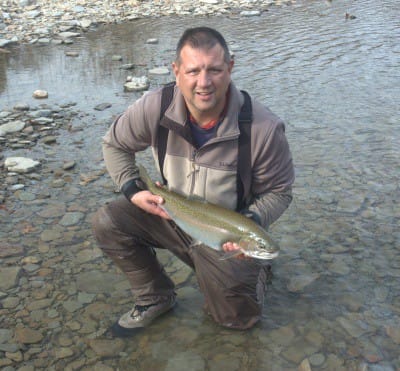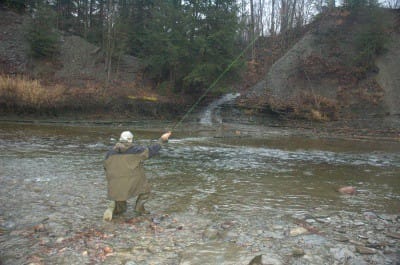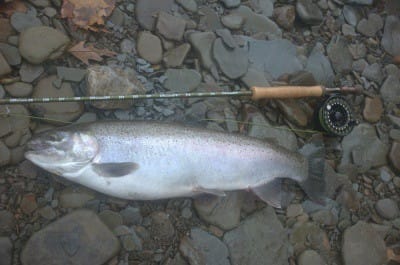
The East can boast its fair share of fine steelhead streams, but few of those waters have the street cred, or the fish, of Elk Creek in northwestern Pennsylvania. As the largest tributary of Lake Erie, the Elk holds more water and therefore more fish than many of the surrounding streams. The fish here are fresh from Lake Erie and fight like there’s no tomorrow once they’re hooked. I well remember my surprise at nearly being at eyeball level with the first steelie I saw jump. I was glad I got a good look at him, because it was the last time I saw him: He broke me off on his leap to freedom.
Steve Vorkapich, inventor of Float Master Indicators, introduced me to the Elk and spent nearly a day and a half showing me the ropes before I finally got the hang of it. It was on Elk Creek that Steve noticed many anglers spent more time rigging and re-rigging their rods than they did fishing. He also noticed too many of the indicators on the market moved up and down the leader when anglers didn’t want them to-or worse, the leaders were cast off the line completely. This led him to develop his own line of indicators that are easy to move, never leave a kink in your leader, and won’t move without your knowledge.
“Steelheaders are constantly making adjustments with their set-ups and the changing river conditions. You might have to change your approach several times a day,” says Steve.
Karl Weixlmann, author and well-known local guide, agrees. “You need to change your approach with the prevailing conditions. To be successful here you need to have what I call carnal knowledge of the river, meaning that you need to spend time fishing this water and see what works and what doesn’t. You just have to fish hard and pay your dues,” Karl said.
There are several places to pay those dues along Elk Creek, but finding a spot with any privacy won’t be easy. The river draws thousands of traditional spin and fly anglers each year, so be ready to spend some time with guys who will sling just about any rig that will land steelhead, including bait. Two places that are quite popular with anglers are Follys End Campground and Uncle John’s Cabins. Follys has a nice little fly shop and sells excellent Smith Brothers hotdogs to cold and hungry anglers. The shop is easily accessed off Route 98 is inviting to everyone, but these guys have a wicked sense of humor: You’re apt to get caught in the crossfire of friendly banter that occurs between owner Jim Phillips and his regular customers. Uncle John’s Campgrounds also offers great access and even has cameras in the trees near the river so you can get a steelie fix before you head off to work.
Steve Brugger, owner of Lake Erie Ultimate Angler in Erie, believes the key to success is teaming up with someone who will show you the ropes, whether it be a guide or another seriously addicted steelheader. “Guys traveling here need to know these fish move a lot. They may be in one section of the river for a week, but after a good rain they may move much further upriver,” he says. “Local guides can save you a lot of time, and let’s face it: We all want to be fishing where the fish are, not where they were.”

Fall is the best times to fish, here with November and December being prime time. It all comes down to how much you can stand the cold. Fishing can last right thought March. While some anglers return all they catch, many more don’t. Regulations vary widely depending on the time of the year and where you are on the creek. For the latest information on Elk Creek contact the Pennsylvania Fish and Boat Commission atwww.fish.state.pa.us. Anglers fishing Elk Creek can also hit Walnut Creek and Four Mile Creek fishing in Lake Erie is also an option. For a more detailed map of the Lake Erie tributaries go to www.sgcmaps.com. Fly anglers typically fish here for hard fighting steelhead. You can however catch the brown trout here and smallies close to the mouth of Lake Erie.
Gear for steelheading varies depending on the size of the water and fish but most anglers use 6-8 weight rods ranging in length from 9-10 feet. The extra length allows for better line control while mending and helps put leverage on a fish once you hook them. Reels are pretty important too, and those with large arbors allow you to gather line quickly. Be sure to check your drag before heading onto the water as a running steelhead is not to be trifled with. Leaders generally run 1x-4x and are 9-12 feet long depending on water clarity, with clearer water require more distance. Flies run the gamut from egg sucking leaches 4-10, eggs in various colors 6-12, and Black Pheasant Tails and soft hackles in sizes 12-18. Wooly buggers in 6-10 will also work in a variety of colors.
There are no gimmicks in steelheading-you just have to go out to the river and learn the hard way. The good news is that once you get the hang of it, you can look the steelhead straight in the eye and let him know who’s boss.

Float Master Products, Brunswick, OH
(440) 669-9928(440440) 669-9928 (440) 669-9928
Chagrin River Outfitters, Chagrin Falls, OH
www.chagrinriveroutfitters.com
(440) 241-7110
Folly’s End Camp Ground, Girard, PA
(814) 474-5730
Gander Mountain.Erie, PA
(814) 868-0880
Lake Erie Ultimate Angler, Erie, PA
(814) 833-4040
Beau Beasley is a member of Local 2068 where he works as a captain for Fairfax County Fire and Rescue on Engine 427. His new book Fly Fishing the Mid-Atlantic: A No Nonsense Guide to Top Waters was just released. You can order an autographed copy from the author’s web-site (www.beaubeasley.com).



